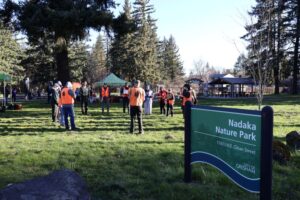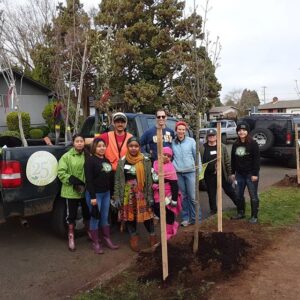Category: climate justice
A Memorial for Lives Lost in the 2021 Heat Dome
72 trees planted for 72 lives lost in Multnomah County
On March 16th at Nadaka Nature Park in Gresham, dozens of volunteers gathered on an especially gorgeous morning, eager to plant trees. While all of our events are climate action, this one had particular significance. All of these new community trees will serve as memorial to the lives lost to the 2021 Heat Dome.
“The 2021 heat dome has brought us into stark understanding of the vulnerabilities of our neighborhoods, where the shade of trees is a precious resource,” says Yashar Vasef, Executive Director for Friends of Trees.
It’s been nearly three years since that historic heat wave with temperatures as high as 119 degrees Fahrenheit, but for many the memory is still fresh. Several families who lost loved ones during the heat dome joined the volunteers at Nadaka to mark the occasion with intentionality and reflect on the purpose of the planting event. The morning was not a somber one, because, as Multnomah County Chair Jessica Vega Pederson put it in her remarks, “planting a tree is a hopeful act.”
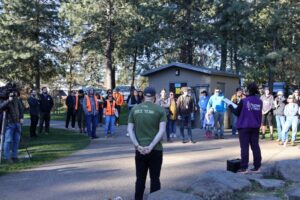
As summer approaches, and with it a chance for another heat wave, it’s important to remember both short and long-term preparedness. We must protect the trees we have, and continue to grow our canopy, especially in neighborhoods that are designated as heat islands.
“In the face of such tragedies, it is imperative that we act decisively on the things we can control,” Yashar says. “Our efforts to plant trees are a stance against the worst outcomes of climate change.”
After remarks from leaders, crews of volunteers headed out into East County neighborhoods to plant street and yard trees that will shade the community. And family members gathered to plant an American hornbeam at Nadaka Nature Park in memory of their loved ones. One family member said they plan to return to the park each year for a family barbecue and to visit and care for the memorial tree.
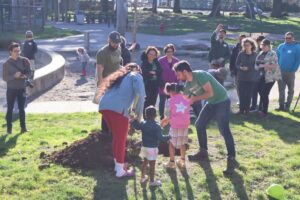
“Each tree we planted helps build a shield against the worst humanitarian impacts of extreme heat,” Yashar says, “and serves as a testament to our shared commitment to building a safer, more resilient community.”
***
The memorial planting event was organized by Friends of Trees, Multnomah County, and the City of Gresham.
Priority Planting
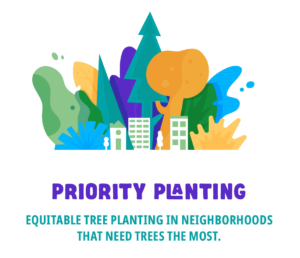
Friends of Trees recognizes that not everyone has equal access to the benefit of trees.
Friends of Trees will always strive to be a welcoming and safe place for everyone, regardless of age, ability, race, religion, sexual orientation, gender identity, political views or economic status. Without our volunteers, we are nothing. But together we do amazing things.
This statement is included at the beginning of all Friends of Trees public planting events
As a community driven organization we foster an atmosphere of inclusion and support, and we strive to build places that are safer and healthy for all. We accomplish this through authentic community conversation; unique partnerships; relevant programming; and attracting and retaining diverse staff and supporters.
Friends of Trees’ Equity and Diversity Inclusion Committee is a standing committee comprised of board and staff who recommend readings and workshops, organize trainings, and review our programs and materials through an equity lens. We use deliberate outreach and communication strategies toward engaging a diverse range of volunteers and tree-recipients. Our board of directors identifies as 55% BIPOC and 66% women; our staff identifies as 53% BIPOC; 50% women; 43% men; 3% gender queer; 3% non-binary.
Community planting goes beyond getting trees in the ground. Friends of Trees’ programs engages volunteers of all ages, races, religions, sexual orientation, gender identity, economic status, and political views to plant and care for trees together. Our programming cultivates partnerships that center climate justice and engages people from historically underserved communities to directly play a part in improving the health and livability of their neighborhoods. We administer environmental education and internships that expand opportunities to enter the green workforce. Authentically engaging communities is crucial toward achieving climate justice.
Read a variety of articles about how we work to deliver programming that is equitable and inclusive.
An update on our Robert Wood Johnson Foundation partnership
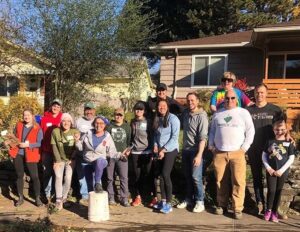
Engaging Community to Take Climate Action
We know that trees fight climate change. And here at Friends of Trees our experience partnering with thousands of community members tells us that the volunteer experience also helps fight climate change – because folks who volunteer to plant and care for trees often go on to become involved with other environmental issues, including taking climate action.
We’re excited to share that through our partnership with the Robert Wood Johnson Foundation, APANO (Asian Pacific American Network of Oregon), Portland State University’s Toulan School of Urban Studies and Planning, OHSU-PSU Joint School of Public Health, and Willamette Partnership, we should soon have quantitative and additional qualitative data to support this. This project recognizes that “where one lives or works, one’s age, if one has pre-existing health conditions or chronic illnesses, and race or income all impacts how and how much climate change harms health.” Friends of Trees’ efforts over the past 20+ years of planting in east Portland and other low-canopy, underserved neighborhoods also recognizes this, and this partnership takes these efforts to the next level, especially around community involvement.
“Engaging with historically marginalized communities about where neighborhood change needs to happen and how it might happen are the first steps to ensuring an equitable urban forestry program.”
– Dr. Vivek Shandas, PSU, School of Urban Studies
A major project milestone is the formation of a community advisory board, facilitated by APANO, and comprised of people who live in, work in, or regularly engage with east Portland’s Jade District. Participants include a Friends of Trees tree recipient, a PSU student, a middle school student, a Rosemary Anderson High School/POIC graduate, a biology educator, and Multnomah County representation. Upcoming CAB activities include a live tree walk in the Jade District, exploring topics such as infrastructure challenges to adding trees (e.g., with so many parking lots, where and how do we plant trees?) and how to address these challenges.
“What’s really exciting about this project is the community advisory board, which isn’t something we usually have the resources to develop.” Michelle Yasutake, Friends of Trees Green Space Program Manager
Michelle’s project role involves a major project milestone, the formation of a community advisory board, facilitated by APANO, and comprised of people who live in, work in, or regularly engage with east Portland’s Jade District. Dr. Shandas is also a strong supporter of direct community involvement, “By integrating community voices with our technical know-how, this project is identifying ‘nature-based solutions’ in areas that have been neglected and disinvested by regional decision makers.”
Friends of Trees wants to do even more to engage people in the community in project planning and prioritizing, and we know that the best way to achieve diverse and authentic representation is to be able to provide stipends in consideration of the time it takes people to participate. The Robert Wood Johnson Foundation recognizes the value of this and its grant includes funding for these stipends. Michelle further emphasizes the importance of community involvement,
“This project, and the community advisory board, are so important to Friends of Trees’ goals around equity, diversity and inclusion and our efforts to genuinely work with the people who actually live and work in the community, and to do so in a way that ensures community members feel like they are truly a part of the process.”
Next steps in the project include data collection through surveying the community; we’re asking questions about neighborhood involvement, civic engagement such as voting, the impact of COVID on household income, and more. We’ll also take on a tangible project such as adding green infrastructure (trees, bioswales, shrubs) to a site identified as a priority by the community; and we’ll be using a research tool called Photovoice.
Photovoice is a hands-on, photography-based research method designed to help community members identify and discuss important community issues and take social action. Photovoice involves using cameras/smartphones to visually document, describe, and discuss important community concerns.
For this Photovoice project, adult and youth community residents will use photography and digital mapping to collaboratively identify and map out important climate, greenspace, and community health concerns—centering the perspectives of residents of East Portland and the Jade District. This will include identifying specific places and spaces that represent important locations of daily climate and greenspace experiences. The goal is to create new local climate and community health data that prioritizes community lived experience and knowledge, such that the data can be used to respond to specific community concerns.
The purpose of this partnership is to “Examine the physical and social dimensions of a tree planting program as a strategy to improve public health and mitigate climate change.” East Portland is one of seven communities across the country where RWJF is studying health, health equity and climate change solutions through its Culture of Health Action Framework, marking RWJF’s first foray into climate health solutions. As this project progresses we’ll share more milestones and updates, so stay tuned!
Photo at top: Friends of Trees East Portland tree planting event, November 2019.
Robert Wood Johnson Foundation funds tree equity project
Robert Wood Johnson Foundation partnership focuses on climate change & community health
Does a community based tree planting program help create a more resilient community? We know that low-income, historically under-served communities – often communities of color – experience the most severe consequences of climate change; part of the reason is that so many low-income communities have so few trees and are missing out on trees’ many benefits (more on that below). A new community partnership with the Robert Wood Johnson Foundation is exploring a better understanding of the comprehensive benefits that trees and community engagement provide.
This partnership is a collaborative research project examining the physical and social dimensions of a community tree planting program as a strategy to improve public health and mitigate climate change. This work includes a local community advisory board, collection and analysis of resident survey data, and the physical analysis of a changing urban tree landscape using data from Friends of Trees’ 30 years of planting trees, focusing on East Portland’s Jade District.
APANO (Asian Pacific American Network of Oregon); Portland State University professors Vivek Shandas (School of Urban Studies) and Ryan Petteway (School of Public Health); Willamette Partnership; and Meyer Memorial Trust join Friends of Trees and the Robert Wood Johnson Foundation as partners in this project. PSU is the lead investigator for the project, managing research design; APANO leads community outreach and engagement as well as the coordination of the community advisory board; and Willamette Partnership is supporting survey design, analysis and communication of lessons learned. Given our 30 years of tree planting and community engagement experience (and thus 30 years of data) Friends of Trees is the project lead, helping develop and collect community surveys, recruit for the community advisory board, and share planting data.
“While climate change can harm the health of anyone in America, some communities and groups of people are more likely than others to be harmed,” said Dr. Mark Mitchell, a public health and environmental health physician. “Climate change exacerbates health disparities in the most vulnerable communities, including tribal communities, communities of color, and low-income communities. That is why culturally relevant solutions that address health equity are critical to creating climate resilience.”
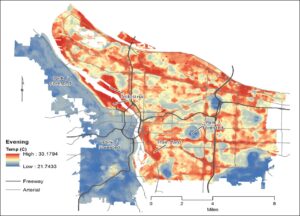
Our community is one of seven across the United States where RWJF is studying health, health equity and climate change solutions. This is a multi-year project, and we’ll share periodic updates along with results at project completion. For more information on health and climate solutions, visit healthandclimatesolutions.org.
Top photo: Friends of Trees planting event in East Portland, February 2020.
Heat map image courtesy of Sustaining Urban Places Research (SUPR) Lab, Portland State University.

